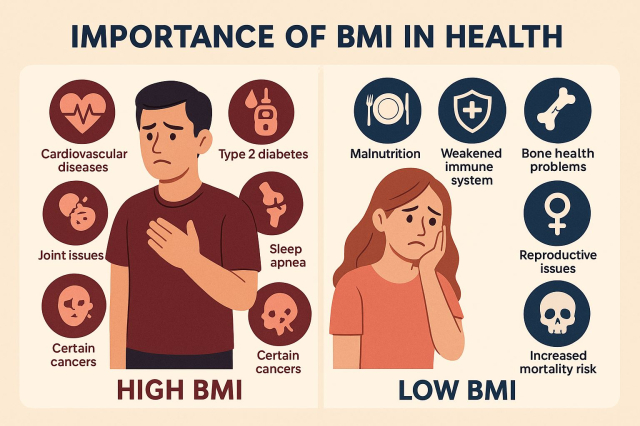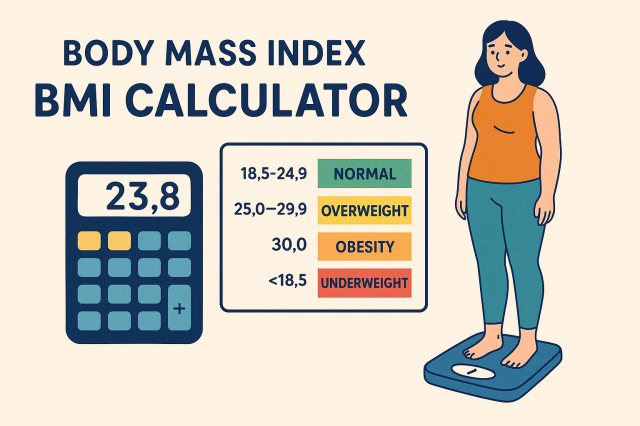The Body Mass Index (BMI) Calculator is a tool used to assess weight status based on height and weight. It helps categorize individuals into different health-related groups. Understanding BMI is essential for recognizing potential health risks associated with high or low weight. This article provides a comprehensive overview of BMI, its calculation, and its implications for health.
Understanding Body Mass Index (BMI)
Understanding Body Mass Index (BMI) is crucial for gauging weight-related health risks. This section delves into the definition of BMI, methods to calculate it, and the categories it encompasses.
What is BMI?
The Body Mass Index (BMI) is a numerical value that provides an estimation of body fat based on an individual's height and weight. It is widely used in both clinical and public health settings to categorize individuals, offering a simple screening tool to help identify potential weight-related health issues. By using BMI, healthcare professionals can monitor population health, set health objectives, and help individuals understand their weight status relative to health risks.
How to Calculate BMI
Calculating BMI is straightforward and requires just two measurements: weight and height. The formula for BMI is:
BMI = weight (kg) / (height (m))²
To perform the calculation:
- Measure weight in kilograms.
- Measure height in meters.
- Square the height value.
- Divide the weight by the squared height.
For example, if an individual weighs 70 kg and is 1.75 m tall, squaring the height gives 3.0625. Dividing the weight by this result yields a BMI of approximately 22.9.
BMI Categories
Based on the calculated BMI, individuals are categorized into several groups to evaluate their weight status:
- Underweight: BMI less than 18.5
- Normal weight: BMI between 18.5 and 24.9
- Overweight: BMI between 25.0 and 29.9
- Obesity: BMI of 30.0 and above
These categories assist in recognizing potential health risks. Individuals in the underweight category may face health issues linked to malnutrition, while those classified as overweight or obese are at risk for numerous conditions such as heart disease and diabetes. Understanding these classifications allows for better management of health and wellness.
Importance of BMI in Health
The Body Mass Index (BMI) serves as a significant indicator of an individual's health status. Understanding its implications can guide people in making informed decisions regarding their lifestyle and well-being.

Health Risks Associated with High BMI
A high BMI often correlates with increased health risks, leading to various chronic conditions. Individuals classified as overweight or obese may experience:
- Cardiovascular diseases: Excess weight puts added strain on the heart, often leading to hypertension and heart disease.
- Type 2 diabetes: Obesity is a major risk factor for developing insulin resistance, which can result in diabetes.
- Joint issues: Increased weight can cause wear and tear on joints, leading to osteoarthritis and chronic pain.
- Sleep apnea: Higher BMI can contribute to obstructive sleep apnea, disrupting healthy sleep patterns.
- Certain cancers: Obesity is linked to an elevated risk of developing cancers, including breast, prostate, and colon cancer.
Health Risks Associated with Low BMI
Conversely, a low BMI can also signify serious health concerns. Individuals with a BMI classified as underweight may face:
- Malnutrition: A low BMI often indicates insufficient nutrient intake, potentially leading to deficiencies and related health issues.
- Weakened immune system: Inadequate nutrition can weaken the body's defense mechanisms, making individuals more susceptible to infections.
- Bone health problems: Individuals carrying little body weight may be at a higher risk of osteoporosis and fractures.
- Reproductive issues: Unbalanced body weight can lead to irregular menstruation or fertility complications in women.
- Increased mortality risk: Studies indicate that underweight individuals have a higher risk of mortality compared to those with a healthy BMI.
Limitations of BMI
Despite its widespread use, BMI has several limitations that can affect its accuracy and reliability as a measure of health. Understanding these constraints is essential for interpreting BMI results responsibly.
BMI and Muscle Mass
One major limitation of BMI is its inability to distinguish between muscle mass and fat. Muscle is denser than fat, meaning a highly muscular individual may have a high BMI but a low body fat percentage. This can lead to a misclassification of their weight status. Athletes and bodybuilders, for example, often fall into the overweight or obese categories despite having healthy body compositions. Thus, relying solely on BMI may not reflect true health conditions in individuals with significant muscle mass.
Demographic Variations
BMI does not account for demographic variations that can impact body composition. Factors such as ethnicity, sex, and genetic background play a critical role in determining how fat is distributed throughout the body. Some populations naturally have different distributions of muscle and fat, which BMI may not accurately represent. For instance, certain ethnic groups may store fat differently, influencing health risks related to weight. This can lead to misinterpretations of health data when using BMI as a sole measurement tool.
Age-related BMI Considerations
Age is another important factor affecting BMI interpretation. As individuals age, body composition often changes; there is typically a loss of muscle mass and an increase in body fat. Consequently, a person's BMI may not appropriately reflect their health status as they get older. Older adults may be classified as overweight when, in fact, they maintain a healthy level of body fat relative to their age. Recognizing these age-related shifts is vital for accurate health assessments.
Alternative Measurements to BMI
In addition to the Body Mass Index (BMI), there are alternative measurements that can provide a more comprehensive understanding of an individual's health and body composition.
BMI Prime
BMI Prime is a metric that offers a different perspective on an individual's weight status. It compares a person's current BMI to 25 kg/m², the upper limit of the normal weight range. This approach allows for a rapid assessment of weight relative to a healthy standard.
The formula for calculating BMI Prime is as follows:
- BMI Prime = BMI / 25
This method can be particularly useful for quickly evaluating the degree of overweight or obesity, providing insights into weight management efforts. A BMI Prime greater than 1 indicates that a person is above the normal weight range, while a value of 1 or less suggests a healthy weight status.
Ponderal Index
The Ponderal Index (PI) offers an alternative evaluation tool that improves upon some of BMI's limitations. Unlike BMI, which uses the square of height in its calculation, PI uses the cube of height, making it potentially more accurate for individuals with extreme body types.
The calculation for the Ponderal Index is as follows:
- PI = weight (kg) / (height (m))³
This index can provide a better understanding of body composition, particularly in people who are very tall or very short. Since the PI considers height differently, it can reflect the physical differences among diverse populations more effectively than BMI.
Both BMI Prime and the Ponderal Index are valuable tools in the assessment of health outcomes. While BMI remains a widely used measure, these alternative indices can enhance the evaluation of weight-related health risks, especially in individuals where conventional BMI may not provide an accurate depiction of health status.
Using Online BMI Calculators
Online BMI calculators provide a convenient way to estimate an individual's Body Mass Index. They enable users to quickly enter their height and weight to receive immediate results without requiring complex calculations.
How Online Calculators Work
Online BMI calculators are typically user-friendly tools designed to simplify the process of calculating BMI. The functionality often includes the following steps:
- The user inputs their current weight in kilograms and height in meters or feet and inches.
- The calculator automatically applies the BMI formula: weight divided by height squared.
- The result is displayed along with a BMI category indicating whether the user is underweight, normal weight, overweight, or obese.
This instant feedback allows individuals to assess their weight status and consider necessary health changes.
Reliable Websites for BMI Calculations
While many websites offer BMI calculators, choosing reliable sources ensures accurate results. Trusted organizations often provide these tools, ensuring that the calculations adhere to medical guidelines. Some recommended sources include:
- Centers for Disease Control and Prevention (CDC) - This national public health institute offers a straightforward BMI calculator along with valuable health information.
- National Heart, Lung, and Blood Institute - This resource includes a BMI calculator and educational material about weight management and cardiovascular health.
- World Health Organization (WHO) - As an international public health authority, the WHO provides a BMI calculator along with context on global health standards.
Using reputable websites contributes to obtaining reliable information and guidance regarding maintaining a healthy BMI.
BMI for Different Age Groups
The Body Mass Index (BMI) provides valuable insights for various age groups, helping to evaluate potential health conditions related to weight. Understanding BMI's implications for children, teens, and adults is key in addressing health management across different life stages.
BMI for Children and Teens
For children and teenagers, BMI is interpreted differently than for adults. It takes into account age and sex, as body composition varies significantly during growth periods. The BMI percentiles for children are used to classify weight status:
- Underweight: BMI less than the 5th percentile
- Healthy weight: BMI between the 5th and 85th percentiles
- Overweight: BMI between the 85th and 95th percentiles
- Obesity: BMI at or above the 95th percentile
These percentiles are crucial as they help identify potential health risks early. Pediatric healthcare providers utilize growth charts specific to age and sex to track a child’s development over time, emphasizing the importance of a balanced diet and regular physical activity during these formative years.
BMI for Adults
In adults, BMI maintains the same calculation method but is interpreted based on set categories that define weight statuses:
- Underweight: BMI less than 18.5
- Normal weight: BMI 18.5 to 24.9
- Overweight: BMI 25.0 to 29.9
- Obesity: BMI 30.0 and above
Adults must monitor their BMI as it serves as a preliminary tool to gauge health issues such as heart disease, diabetes, and other obesity-related conditions. Regular check-ups and lifestyle evaluations are essential for maintaining a healthy BMI in adulthood. Weight management strategies may include dietary adjustments and increased physical activity, which are vital for overall well-being.
Tips for Maintaining a Healthy BMI
Maintaining a healthy BMI involves a balanced approach to diet, nutrition, and physical activity. Adopting a combination of healthy eating habits and regular exercise can significantly contribute to weight management and overall well-being.
Diet and Nutrition
A well-rounded diet is crucial for achieving and maintaining a healthy BMI. It should focus on nutritious foods that provide essential vitamins and minerals while helping to manage weight. Key components include:
- Fruits and Vegetables: Aim for a variety of colors and types. These foods are rich in nutrients and low in calories, making them ideal for weight management.
- Whole Grains: Incorporate whole grain bread, brown rice, and oats into meals. Whole grains provide fiber that aids in digestion and helps keep one feeling full.
- Lean Proteins: Sources such as chicken, fish, beans, and tofu are excellent options. These help build muscle while being lower in fat.
- Healthy Fats: Include avocados, nuts, and olive oil. These fats are beneficial in moderation and can enhance satiety.
- Hydration: Drink plenty of water throughout the day. Staying hydrated is important for overall health and can help control hunger.
Portion control is also essential. Understanding serving sizes and practicing mindful eating can prevent overconsumption and promote a balanced diet.
Regular Physical Activity
Engaging in regular physical activity is a vital component of maintaining a healthy BMI. Exercise helps burn calories, build muscle, and improve overall health. Recommended activities include:
- Aerobic Exercise: Aim for at least 150 minutes of moderate aerobic activity, such as walking, cycling, or swimming, each week. This can improve cardiovascular health and aid weight management.
- Strength Training: Include muscle-strengthening activities at least twice a week. Building lean muscle increases metabolism and supports weight loss efforts.
- Flexibility Exercises: Incorporating yoga or stretching routines can enhance flexibility and overall physical performance, reducing the risk of injury.
Finding enjoyable activities is important to maintain consistency. Choosing exercises that are fun and engaging increases the likelihood of sticking to a routine.
FAQs about BMI and Health
This section addresses common inquiries regarding Body Mass Index and its relevance to health. Understanding these questions helps demystify the use and implications of BMI in personal and public health contexts.
Common Misconceptions
Many misunderstandings surround BMI and its interpretation. Recognizing these misconceptions is vital for accurate evaluations of health status.
- BMI is a perfect measurement of health: Many believe that BMI dictates overall health. However, it primarily assesses weight in relation to height and does not account for muscle mass, bone density, or overall fitness.
- Only overweight individuals should worry about BMI: While a high BMI often indicates weight issues, having a low BMI can also pose significant health risks, such as malnutrition and bone density loss.
- BMI is irrelevant for athletes: Athletes may have high BMIs due to increased muscle mass. Thus, it can be misleading for physically fit individuals who possess a lower body fat percentage.
- BMI is a one-size-fits-all solution: The formula does not consider demographic variations such as age, gender, or ethnicity, which can affect body composition.
Professional Guidance and BMI
Consulting healthcare professionals regarding BMI measurements is crucial for personalized health assessments. Professionals can provide context and additional tests to evaluate an individual's health status more accurately.
- Doctors and nutritionists: They can interpret BMI results within the larger framework of an individual's medical history and lifestyle.
- Comprehensive health evaluations: Professional guidance often includes more than BMI; it may encompass waist circumference, body fat percentage, and other health indicators.
- Personalized health plans: Based on BMI and other metrics, healthcare providers can recommend tailored dietary and exercise plans to help achieve a healthy weight.
- Reevaluation of BMI: Situations change, and regular consultations are necessary to reassess BMI's relevance in ongoing health management.
BMI and Public Health Resources
Understanding the Body Mass Index (BMI) is essential in promoting health awareness. Various public health resources provide guidelines and valuable information related to BMI and its implications in health management.
Official Health Guidelines
Official health guidelines serve as important tools in educating the public about maintaining a healthy weight. These guidelines are typically published by authoritative health organizations, which evaluate the scientific evidence and recommend actions to improve public health. Some key components often include:
- Recommendations for healthy eating patterns, including a balanced diet rich in fruits, vegetables, whole grains, and lean proteins.
- Physical activity guidelines that suggest at least 150 minutes of moderate-intensity aerobic exercise per week.
- Strategies for weight management that emphasize gradual, sustainable lifestyle changes rather than quick fixes.
- Advice on avoiding foods high in saturated fats, sugars, and sodium while focusing on nutrient-dense options.
These guidelines help shape public policies and health programs aimed at reducing obesity rates and improving overall health within communities.
Centers for Disease Control and Prevention Information
The Centers for Disease Control and Prevention (CDC) is a leading health organization that provides crucial information and resources related to BMI and overall health. The CDC strives to enhance public knowledge through various informative campaigns and publications. Key topics include:
- The impact of obesity on chronic diseases such as diabetes, heart disease, and certain cancers.
- Statistics and data on weight trends among different populations and age groups.
- Interactive tools and resources, including BMI calculators and assessment charts for individuals seeking to evaluate their weight status.
- Community-level interventions aimed at creating environments that support healthy lifestyles.
Through these efforts, the CDC aims to empower individuals and communities to take proactive steps toward achieving and maintaining a healthy weight.




